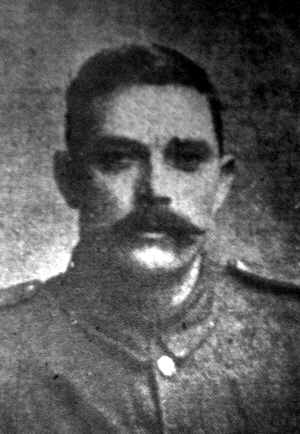 Gunner Oliver Smith, 84085, Royal Garrison Artillery, 195th Heavy Battery
Gunner Oliver Smith, 84085, Royal Garrison Artillery, 195th Heavy Battery
Oliver Smith was born in Ossett in early 1881, the son of Edmund Smith and his wife, Catherine (nee Bedford), who married in late 1859 and had nine children, but sadly four children died before April 1911. In 1891 and 1901 Edmund Smith, his wife Catherine and their family, including Oliver, were living at Healey, Ossett where Edmund worked as an overlooker of scribblers in a mill.
By 1901, Oliver was working as a fellmonger. Oliver's mother, Catherine Smith, died in late 1901, aged 63 years, and in 1911, 79 year-old pensioner, Edmund Smith, was living at 8, Healey Road, Ossett, (Gelder’s Buildings) close to the Millers Arms public house. He was a widower living with his son Oliver, aged 30, his daughter Sarah aged 44, and a 3 year-old child Edmund, described as a son, presumably Sarah's Smith's son.
In 1911, Oliver Smith was working as a fellmonger for Godfrey Illingworth of nearby Rookery Farm, Healey, Ossett. Edmund Smith died in Spring 1912, aged 80 years.
On the 15th July 1916 Oliver Smith married Annie Land at the New Wesleyan Chapel Ossett and they set up home at 35, Headlands Road, Ossett. Oliver Smith, a fellmonger’s manager, of 2, Fawcett’s Buildings, Healey enlisted at Ossett on the 29th November 1915. He was 34 years and 11 months of age, 5’11” tall with a 41” chest measurement, and therefore somewhat larger in stature than the average Ossett army recruit back in 1915.
He was posted to army reserve with the service number 84085, and joined the Royal Garrison Artillery, as a gunner on the 19th June 1916, and was attached to the 195th Heavy Battery on the 4th July 1916. He was mobilised on the 9th March 1917, embarking for Egypt the following day and arrived in Alexandria on the 30th March 1917.
Just three weeks later on the 23rd April 1917, in Alexandria 21st General Hospital, Oliver Smith died of pyaemia, a type of septicaemia which was almost universally fatal before the introduction of antibiotics. On the 27th April 1917, his personal effects were collected together for forwarding to his widow, Annie. They comprised an engraved cigarette case (engraved O.S.), 2 identity discs, safety razor in case, cap badge, key, pair titles (R.G.A.), razor strap, photos and cards.
In 1919, Oliver’s widow, Annie Smith, had the task of informing the army of Oliver’s closest living relatives. He had no children and three surviving brothers: Walter Smith, aged 45, and living at 4, Thornhill Street, Savile Town, Dewsbury; Harry Smith, aged 43, and living at South Street, Ossett and Willie Smith, aged 40, of Beverley Road, Hull.
Gunner Oliver Smith was posthumously awarded the British and Victory medals and with effect from the 29th October 1917, Oliver’s widow Annie was awarded a pension of 13/9d a week.
The "Ossett Observer" 1 had this obituary for Oliver Smith:
"Ossett Soldier's Death In Egypt - A member of a well-known and respected Healey family, Gunner Oliver Smith (36), of the Royal Garrison Artillery, is officially reported to have died in hospital at Alexandria, Egypt on the 23rd ult. According to a cheery letter from him received by his sister, written ten days before his death; he was then in good health, but complained that the weather was exceedingly hot. Of fine physique, he went into the army about a year ago, and only recently went to the East. In civil life he followed the occupation of a fellmonger, and had been in the service of the same employer, Mr. Godfrey Illingworth, of Healey, since he left school. He recently married."
Gunner Oliver Smith, aged 36 years, died on the 23rd April 1917. He is buried at grave reference D.102 at the Alexandria (Hadra) War Memorial Cemetery,1 Egypt. Hadra is a district on the eastern side of Alexandria and is south of the main carriageway to Aboukir, known as Al Horaya, near the University of Alexandria.
In March 1915, the base of the Mediterranean Expeditionary Force was transferred to Alexandria from Mudros and the city became a camp and hospital centre for Commonwealth and French troops. Among the medical units established there were the 17th, 19th, 21st, 78th and 87th General Hospitals and No 5 Indian Hospital. After the Gallipoli campaign of 1915, Alexandria remained an important hospital centre during later operations in Egypt and Palestine and the port was much used by hospital ships and troop transports bringing reinforcements and carrying the sick and wounded out of the theatres of war.
This cemetery was begun in April 1916 when it was realised that the cemetery at Chatby would not be large enough. Most of the burials were made from the Alexandria hospitals, but a number of graves of December 1917 were due to the loss of the troop transports "Aragon" and "Osmanieh" which were sunk by torpedo and mine as they entered the port. The cemetery continued in use until December 1919 but later, some graves were brought in from small burial grounds in the western desert, Maadia and Rosetta.
There are now 1,700 First World War burials in the cemetery and 1,305 from the Second World War. The cemetery also contains war graves of other nationalities and some non war burials.
References:
1. "Ossett Observer", 5th May 1917